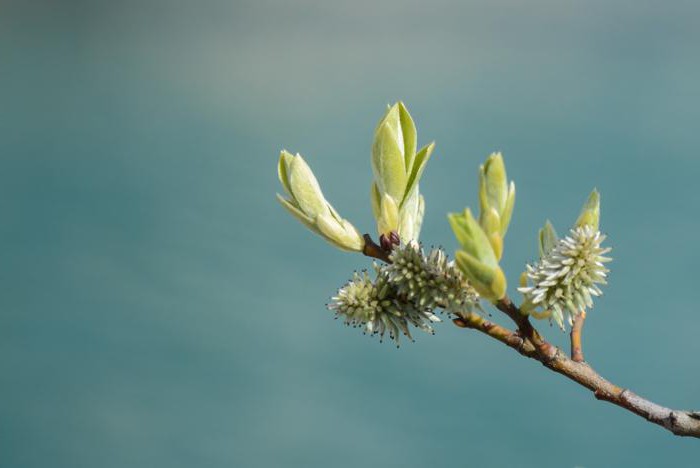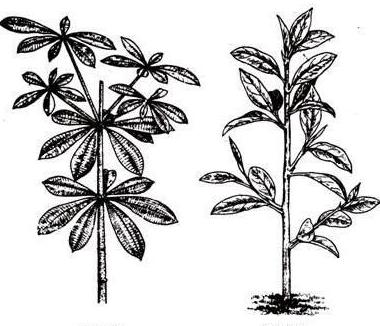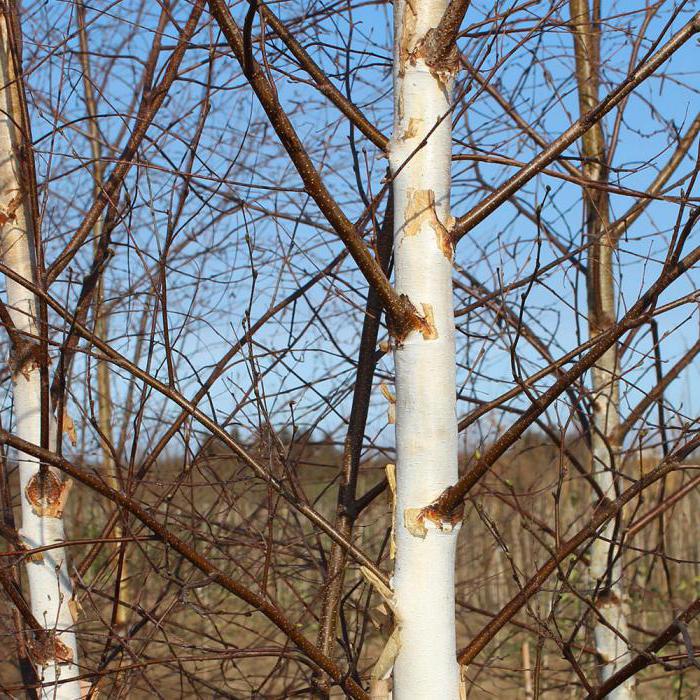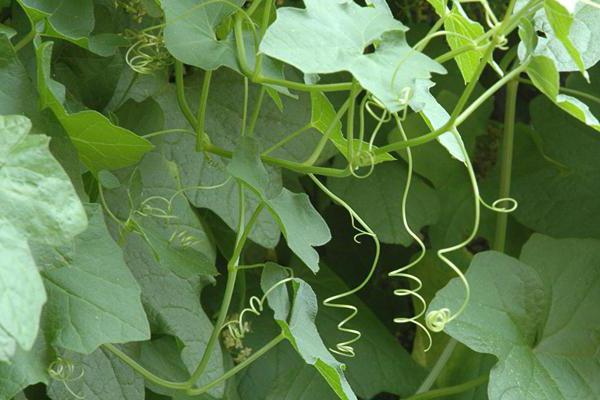Escape: structure and types
The shoot of a plant is one of the main vegetative organs. It consists of three parts: root, stem and leaf. In all currently existing higher plants, they are homologous to each other and perform different functions.
Shoot phylogeny
In the context of the historical development of organisms, called phylogeny, escape is regarded as an adaptation to a terrestrial lifestyle. It arose as a result of the transformation of rhinophytes of telomes (leafless cylindrical organs) in primitive vascular plants. The emergence of a shoot is the largest aromorphosis in the history of the development of the plant world. This progressive change led to an increase in photosynthetic surface area, associated transpiration, and, as a result, promoted the development of true roots.
Ontogenesis
With the individual development of the organism (ontogenesis), the shoot of the plant is formed from the buds of the embryo, or adnexal or axillary buds. They are, in fact, the beginnings. When the seed germinates from the germinal bud, the first shoot of the plant develops, also called the main or first order. Lateral branches develop from it.
Types of shoots depending on the function performed
- Vegetative shoots are unmodified. They consist of a stem, buds and leaves. The main function is air supply and ensuring the process of synthesis of inorganic and organic substances.
- Generative shoots are modified. In them, the process of photosynthesis is not carried out, as a rule. However, sporangia are formed on them, the main task of which is to ensure the process of plant reproduction.
- Vegetative-generative, that is, a partially modified shoot. It has leaves, stem, buds and flowers or inflorescences at the same time. Accordingly, it combines the two functions mentioned above at once.
Often the shoot on which the formation of flowers occurs is called the flower-bearing or abbreviated "peduncle".
Escape: building

Without exception, all shoots carry leaves that are not always visible to the eye (for example, scaly on rhizomes). A woody plant is characterized by their absence in perennial plots. Old leaves, after the formation of a special separating tissue, fall off at the end of each season - this is a feature of deciduous species. In the spring, the growth process begins anew.
The place where a leaf is attached to a stem is called a node. In many plants, it is thicker than in other areas. The part of the shoot located between the nodes is the internode. Their alternation expresses the metameric structure of the branches. The repeating structural unit in this case is a node with a leaf and an internode - a phytomer.
Often, the length of the internode can differ significantly on the shoots of the same plant. Quite often one can meet in nature fluctuations in one direction or another. So, strongly shortened internodes lead to the emergence of rosette shoots and bulbs, and excessively elongated, to the development of stolons or peduncles.
Growth features
Summarizing the above, we can say that the stem with leaves and buds, formed from the meristem, is an unmodified vegetative shoot. In temperate latitudes, their growth and development is periodic. As a rule, in most shrubs, trees and perennial grasses, it occurs once a year (in spring or summer). Such shoots that grow in one year are called annual shoots. In perennial plants, an apical bud is formed at their end; in fact, it is the beginning of a future shoot, which is a continuation of the main axis.

In cases where the growing season consists of several stages of growth, which are separated by a weakly pronounced dormant period, the growing shoots are called elementary. This is especially true for oak. The tree forms shoots in spring and mid-summer. In the tropics there is no clear division into seasons. In this regard, many citrus fruits, a tea bush, etc., can form from 3 to 7 elementary shoots per year.
branching shoots
The process of formation of lateral branches by a shoot, their relative position on a stem, rhizome or perennial branch is called branching. In this way, the plant increases the above-ground mass and surface area, and hence the power of photosynthesis. The order in which the main shoot and buds are located serves as a criterion for classifying branching. It can be dichotomous, monopodial and sympodial. These species are characteristic of higher plants; in lower plants, branching leads to the formation of a thallus (thallus).
The main shoot or axis of the first order develops from the apical bud, its lateral stems are the axes of the second order. They keep branching out. In this case, axes of the third, fourth, etc. order are formed. Let's dwell on each type of branching in more detail.
Dichotomous branching
![]()
This type of branching is the most primitive. It is characteristic of algae, such as fucus, club mosses, some gymnosperms, mosses and ferns. With dichotomous branching, the growth cone is divided in two, as a result, two side branches are formed. They, in turn, grow in a similar way further. At the same time, the shoot, the structure of which was discussed above, forms a bizarre "tree" (pictured).
Dichotomous branching can be isotomous, when the newly formed branches are of the same length, or anisotomous, when they are unequal.
Monopodial branching
More progressive in evolutionary terms is monopodial branching. Plants with this type of shoot structure retain the apical bud throughout their lives. The increase in height occurs due to the main axis. Lateral branching shoots can depart from it. However, they are never above the main. Monopodial branching can most often be found in representatives of the group of gymnosperms, some angiosperms (palms, orchids, etc.) plants. A classic example is the pleasing phalaenopsis, common in room culture, which has only one vegetative shoot.

Sympodial branching
Sympodial branching is the most advanced and complex type compared to the previous ones. It is characteristic of angiosperms. The escape structure, which falls under this type, is distinguished by the fact that its bud (apical), ending its development, dies off or stops its growth. New stems begin to develop at its base. Moreover, such side shoots outgrow the main one, take on its direction and appearance. Sympodial branching has, in particular, birch, linden, hazel, and most flowering plants.

The most variable in appearance organ of plants is the shoot. Its structure remains the same, but it can take on a variety of forms. This property is mainly associated with the multifunctionality of all vegetative organs that arose in the course of evolution, and the changes that occur in ontogeny, which are due to the adaptation of the plant to various external conditions.
Shoot metamorphoses have a very wide range: from small deviations from the typical structure to completely changed forms. Both underground and above-ground parts can be modified.
Metamorphoses of above-ground shoots
The modifications that occur with the shoot, listed below, are the consequences of the adaptation of the plant to special conditions of existence or an unusual way of life. These formations can serve not only for reproduction and reproduction, the accumulation of nutrients, but also perform other functions.
- Whiskers and elevated stolons. These modifications of the stem are intended for vegetative reproduction of the plant, i.e., the settlement of its daughter individuals. Such shoots can carry leaves and carry out photosynthesis in parallel. A typical example is the whiskers of wild strawberries, stolons of indoor chlorophytum.
- Antennae.

- As a rule, climbing plants have them. The antennae are a flagellate shoot (branched or solitary), devoid of leaves. They are highly specialized formations that perform a supporting function in species that cannot independently maintain a vertical position. Antennae have, for example, such climbing plants as peas, morning glory, as well as representatives of the Pumpkin family (cucumber, watermelon, pumpkin, melon).
- Thorns are strongly shortened lignified leafless shoots with a sharp top. They are a protective adaptation of plants.
- Rosette escapes. They have very short internodes, as a result of which the leaves are arranged in a rosette. For example, like plantain, dandelion, daisy.
- Phyllocadium is a lateral shoot with limited growth, flattened and performing the function of a leaf. Characteristic for representatives of the genus asparagus, phyllanthus.
- Claudius. In order to understand what it is, just look at parts of the stem of the indoor Decembrist, prickly pear cactus. This is a modified shoot, characterized by long growth. It has flattened stems that act as leaves, while the latter are practically reduced.
Metamorphoses of underground shoots

Shoots located underground are very different from those above ground. They almost completely lost the function of photosynthesis, but acquired others, no less important. For example, the supply of nutrients, reproduction, resumption of vegetative growth. Modifications of the underground shoot are: caudex, rhizome, stolon, bulb and corm.
- Caudex - a modified section of the stem, located between the cotyledon leaves and the tap root. It has the appearance of a thickening, persists throughout the life of the plant and serves as a storage place for reserve nutrients, and also carries numerous renewal buds, including dormant ones. For example, lupins, adenium, alfalfa.
- Rhizome - a modified underground shoot, characteristic of perennial grasses, shrubs and semi-shrubs. Outwardly, it is very similar to the root. The main difference lies in the location and growth in a horizontal plane, the presence of scale-like leaves and the absence of a root cap.
- An underground stolon is an annual thin elongated shoot located underground, at the end of which tubers and bulbs (potatoes, adoxas) can develop.
- The bulb is a specialized, greatly shortened shoot, most often underground. It is a typical organ of vegetative renewal and reproduction.
- The corm is also a shortened modified underground shoot. However, in addition to the function of vegetative reproduction, it stores assimilates in itself. For example, gladioli, dahlias, cyclamen, callas, etc.



